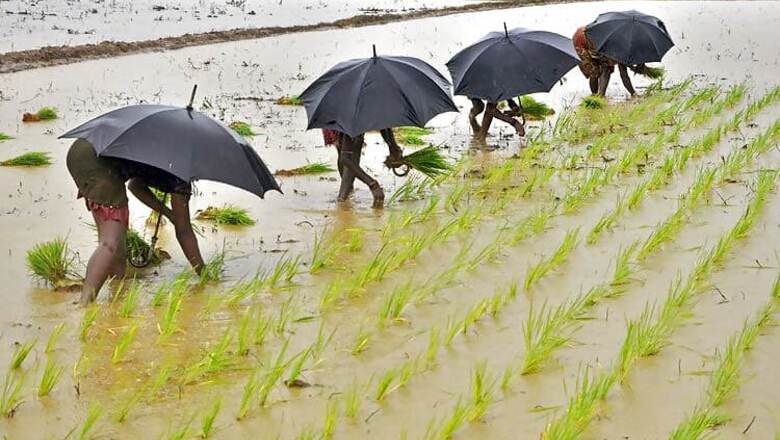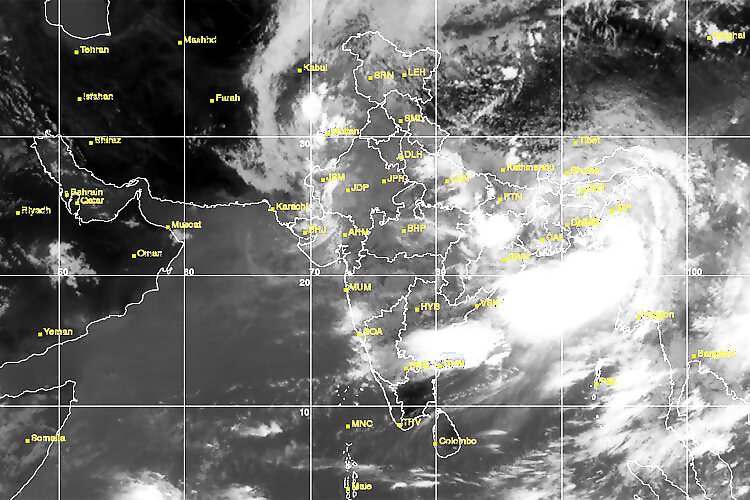
views
New Delhi: More than half of Monsoon season is over. The progress of Monsoon across India has been inconsistent this year, and the fear of a deficit Monsoon is still looming large over India. While some of parts of India have received a good rainfall, some have received excess and some parts have received a scanty rainfall.
The spread of Monsoon has not been uniform all over India. According to private weather monitoring website Skymet, the delay in onset of Monsoon did not affect the performance of Monsoon. A Skymet report said, "First week of the month observed normal rainfall. According to the data available with Skymet, Northwest, East and Northeast India observed surplus rain during this period while rainfall in Peninsular India was normal. Central India was the only region where rainfall was deficient by 26%. Overall the country observed normal rain during this week".
In the second week, it was 11% excess, the third week excess was by 16%. Central India has observed maximum amount of rain and is surplus by 32%. With 133 mm of rain against the average of 103 mm, Peninsular India had an excess of 30%. East and Northeast India was surplus by 3%, though the deficiency in NMMT (Nagaland, Manipur, Mizoram and Tripura) was 42%.

In the third week, the excess rainfall was 16%. In the fourth week, the intensity of rain increased, with all the four regions reporting surplus rainfall. The cumulative rainfall for the country from June 1 to June 28 was 176.5 mm against the normal average of 148 mm, making it 19% excess.
Looking at the region wise distribution of rainfall, Central India topped the list as it witnessed highest rainfall and is 32% excess. This was followed by Peninsular India which is surplus by 26%. With increase in rainfall over Uttar Pradesh, Northwest India recovered from deficit and is surplus by 25 %. East and Northeast India continue to be surplus by 3%, though Bihar was deficient by a margin of 24%.Out of the 36 sub-divisions, 32 sub-divisions that account for 90% of the country’s area got surplus rainfall while four sub-divisions remained deficient. We expect June to end with rainfall surplus of at least 15%, which could be a record in recent past.

Therefore, the cumulative rainfall for the country from June 1 to July 5 was recorded at 207.8 mm against the normal average of 206.7 mm. Though, this is considered to be normal, the performance of Monsoon is poor compared to the previous week.
Deficient at many places
The sub-division of Haryana and Delhi in Northwest India turned deficient from being normal. Punjab and Himachal Pradesh have also turned deficient. In Central India, the sub-divisions of Gujarat and Marathwada were excess but now they have turned deficient. In Peninsular India, three sub-divisions which include Coastal Karnataka, North Interior Karnataka and Kerala have also turned deficient.
However, with good rainfall expected across the country from July 6 the deficient sub-divisions in North and East India could make some recovery.
In the sixth week, Southwest Monsoon during the first half of the week was subdued. The countrywide rainfall between July 8 and July 9 was deficient by 4%. Meanwhile, the cumulative rainfall for the country from June 1 to July 12 stands at 266.3 mm against the normal average of 270.8 mm, which is short by 2% says a Skymet report.
In the seventh week the first half of the week, witnessed poor Monsoon rains. The countrywide rainfall deficiency kept on mounting and rose from 3% on July 12 to 7% on July 15. On July 12, the country was deficit by 30 mm of rain, for the month. To be precise, from July 1 to 12 the country should have received 107.2 mm of rainfall. But, it had received only 76.8 mm.
The rainfall deficiency took a big jump within next 3 days and mounted up to 48 mm. Till July 17, the country received 106.7 mm of rainfall against the normal average of 154.8 mm. The rainfall deficiency got arrested after July 17 and the next 3 days witnessed Monsoon showers across most parts of the country. However, the countrywide rainfall deficiency is still at 7% as of July 20.
The rainfall deficiency for the month of July witnessed a marginal drop only and came down from 28.4% on July 12 to 27.8% on July 20. All thanks to good Monsoon showers from the 18th of this month.
West Madhya Pradesh performed extremely well in the last one week. The cumulative rainfall figure in the region rose from a surplus of 4% on July 12 to a surplus of 23%, in span of just 8 days. Similarly, Kerala also performed relatively well.
In the eighth week daily countrywide rainfall during the first two days of the week was close to normal due to which the cumulative seasonal deficiency from June 1 to July 22 stagnated at 7%. From the third day (July 23) onwards the amount and intensity of rain increased by almost 15%. This could be understood from the fact that the countrywide deficiency from June 1 to July 27 slipped to 4% compared to 7% till July 22.
Even the highest 24 hour rainfall for the country was observed on July 26. According to the data available with Skymet, the country received 14.1 mm of rain against the daily average of 9.7 mm, which is 45% excess.
According to Karnataka government reports, half of the state has received a deficit and scanty rainfall leading to drought like situation in 83 taluks in the state.
80% of India Gets Excess or Normal Rain
According to a Bloomberg report almost 80 percent of India received excess or normal downpours since June 1, allowing farmers to begin sowing of rice, cotton, corn and soybeans in the south, west and central regions, according to the Meteorological Department. The good showing is set to continue through June, it estimates.
A better-than-expected start to the monsoon in an El Nino year has eased concerns of dry weather fuelling inflation in Asia’s third-largest economy, where food costs represent almost half of the consumer price index. Normal rainfall is critical for Prime Minister Narendra Modi’s plan to accelerate economic growth in a country where smartphone makers to gold jewelry retailers derive the bulk of their sales from 833 million people living in villages, most of whom depend on farming.
According to Skymet August is expected to begin on a rainy note. The national capital will also receive good rains on the first day of August itself. Also, most parts of India will observe fairly good rains for the first ten days of the coming month.


















Comments
0 comment